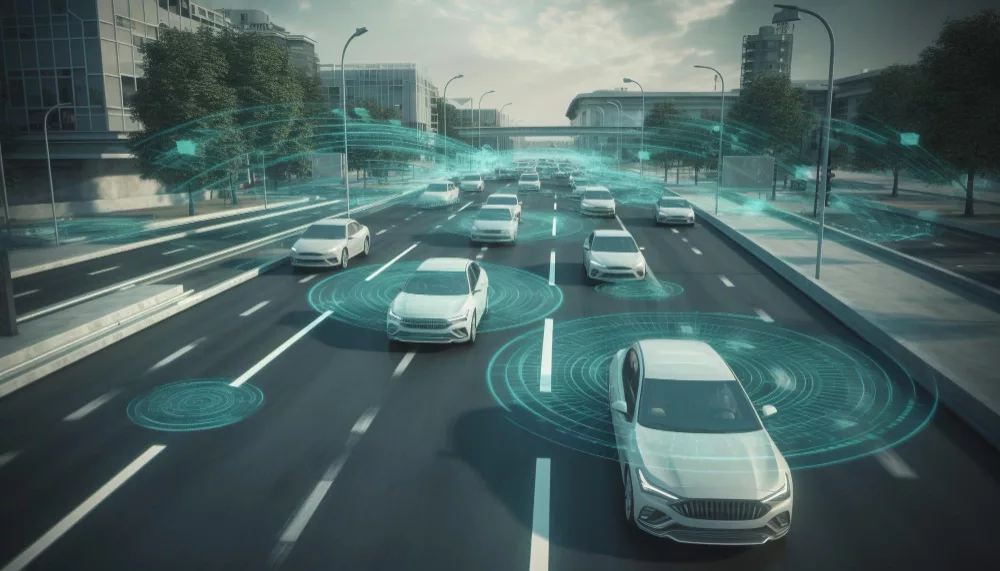4 Key Trends of Vehicle Software and Electronics
The automotive industry is undergoing a new era of advancements in vehicle software and electronics. Four prominent technological trends are driving innovation in this field:
- Autonomous driving
- Connectivity
- Electrification
- Shared mobility like car-sharing.
These 4 trends, known as the ACES trends, will significantly influence the demands on computing and mobile networks.

Among these trends, autonomous driving stands out due to its demand for enhanced onboard computing power to process extensive sensor data in real-time. Furthermore, technologies like over-the-air updates, integration of third-party services, and other autonomous features will also require robust and intelligent connectivity inside and outside the vehicle. Similarly, the increasingly strict safety standards for vehicles call for faster and highly reliable mobile networks with minimal delays.
Impacts of Edge Computing and 5G on the Automotive Sector
The advantages of 5G technology include its ability to cater more effectively to the requirements of connected-car scenarios, with improved bandwidth, reduced latency, dependable performance, and decentralized capabilities. Its positive impacts on automotive apps can be grouped into three primary categories:
- Enhanced mobile broadband (EMBB): 5G has the potential to offer faster and consistent user experiences, achieving speeds of up to ten gigabits per second. This speed is five to ten times faster than what 4G technology can provide. This enhancement is particularly beneficial for data-intensive applications within vehicles like in-car entertainment, vehicle remote operation, and real-time rendering of human-machine interfaces.
- Massive Internet of Things (IoT): Through its capacity to support up to a million connections within a square kilometer, 5G networks are well-equipped to accommodate a large volume of simultaneous connections from automobiles on the road, connected infrastructure endpoints, and end-user devices. This capability reduces the risk of unintentional disconnections from the mobile network due to excessive connections.
- Ultra-low-latency communications (URLLC): The latency of 5G technology can be reduced to as low as one millisecond, surpassing 4G by a factor of five to fifteen. This unique attribute combines rapid data transfer with high reliability, eliminating the need to compromise between the two. This low latency is crucial for tasks such as object tracking in autonomous vehicles, safeguarding and managing critical infrastructure in smart grids, as well as remote control and process automation in domains like aviation and robotics.

These advantages contribute to an increased adoption of edge computing within the automotive industry. Functions that aren’t critical to safety, such as infotainment can transition from being processed solely onboard to being handled at the edge. Currently, most automotive applications exclusively depend on a single location for processing workloads. In the future, a blend of edge computing, onboard processing, and cloud processing may be applied to achieve enhanced performance.
For example, smart traffic management systems can improve onboard decision-making by supplementing the vehicle’s internal sensor data with external information (like telemetry data from other vehicles, real-time traffic updates, maps, and camera feeds). Data can be stored in various locations and then integrated by the traffic management software. Ultimately, the vehicle itself will make the final safety-critical decision.
The Importance of Cybersecurity in the Automotive Sector

While 5G and edge computing play vital roles in driving innovation, they also bring about vulnerabilities that can result in costly consequences for original equipment manufacturers (OEMs), highlighting the critical importance of cybersecurity. Enhancing automotive cybersecurity can be accomplished by implementing new operational approaches in four primary domains:
- Enhancing vehicle cyber risk management through establishing governance frameworks and clearly defined responsibilities for ensuring the cybersecurity of vehicles and associated domains.
- Strengthening vehicle security by incorporating secure engineering practices during the research and development phase and seamlessly integrating cybersecurity considerations into supplier audits.
- Promptly responding to security incidents by instituting effective mechanisms for detecting threats promptly and responding with secure actions.
- Delivering safe and secure software updates by devising processes that allow for the secure updating of vehicle software without compromising safety considerations.
How Companies can Increase Values by Leveraging New Technologies
Semiconductor companies

The automotive semiconductor market is a promising subset within the global semiconductor industry. Semiconductor firms that shift their focus from being hardware-centric entities to becoming providers of comprehensive solutions may find it easier to distinguish their products from their competitors.
As semiconductor companies assess their products, they can identify opportunities to expand their influence in software and create more tailored chips designed for specific purposes. This can include microcontrollers for advanced driver-assistance features, intelligent cockpit systems, and power-control mechanisms.
To enhance expertise in crafting purpose-specific chips, semiconductor companies could gain advantages from better comprehending the requirements of both OEMs and consumers and understanding the novel demands for specialized silicon components. By forging strategic partnerships with major cloud providers and players specializing in edge computing, semiconductor companies can leverage their capabilities in edge and cloud domains, particularly those focusing on the automotive sector.
OEMs

Capitalizing on the transformative influence of 5G and edge computing, OEMs have the opportunity to reshape their business approaches towards providing as-a-service solutions. They can also harness their existing resources and competencies to create applications or concentrate on delivering top-tier contract manufacturing services.
When OEMs embark on partnerships with established and emerging players in the value chain, they should prioritize two primary considerations: addressing gaps in expertise and capabilities, such as those pertaining to chip development, and effectively managing diverse portfolios of projects.
Consider leveraging the power of edge computing?
The benefits of 5G and edge computing are tangible and quickly approaching, but it’s essential to recognize that no single player can navigate this path alone. Currently, substantial opportunities remain inadequately covered within the technological strategies of automotive firms, and not everyone is capturing them.
CMC Global has emerged as a significant player in the realm of edge computing within the automotive sector, playing a pivotal role in shaping the industry’s technological landscape. With an understanding of the transformative potential that edge computing holds for the automotive sector, CMC Global has positioned itself at the forefront of innovation, offering tailored solutions that leverage the power of edge computing to address critical challenges and unlock new opportunities.
Contact us for further consultation.





